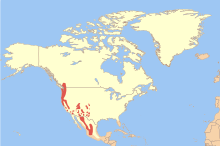Mexican spotted owl
| Spotted owl | |
|---|---|
 |
|
| Northern subspecies | |
| Scientific classification | |
| Kingdom: | Animalia |
| Phylum: | Chordata |
| Class: | Aves |
| Order: | Strigiformes |
| Family: | Strigidae |
| Genus: | Strix |
| Species: | S. occidentalis |
| Binomial name | |
|
Strix occidentalis Xantus de Vesey 1860 |
|
| Subspecies | |
|
3, see text |
|
 |
|
3, see text
The spotted owl (Strix occidentalis) is a species of true owl. It is a resident species of old-growth forests in western North America, where it nests in tree holes, old bird of prey nests, or rock crevices. Nests can be between 12 and 60 metres (39 and 197 ft) high and usually contain two eggs (though some contain as many as four). It is a nocturnal owl, which feeds on small mammals and birds. Three subspecies are recognized, ranging in distribution from British Columbia to Mexico. The spotted owl is under pressure from habitat destruction throughout its range, and is currently classified as a near-threatened species.
The spotted owl has an average length of 43 cm (17 in), wingspan of 114 cm (45 in), and weight of 600 g (1.3 lb). Its eggs are a little over 50 mm (2.0 in) long, and are white and smooth with a slightly grainy texture. The spotted owl is similar in appearance to the barred owl, but has cross-shaped markings on the underparts, whereas the barred owl is alternately barred on the breast and streaked on the belly. Barred owls are larger and grayer than spotted owls. In recent years, the California and northern subspecies of spotted owl have been displaced by barred owls, which are more aggressive, have a broader diet, and occur in more varied habitats. Though the two species may hybridize in areas where displacement is occurring, they are genetically quite distinct.
The Gila Wilderness is home to the largest population of the Mexican subspecies.
The northern spotted owl has a nearly contiguous range from southwestern British Columbia south through western Washington and Oregon to Marin County, California. The California spotted owl's range overlaps this range in the southern Cascade Range, and extends south through the western Sierra Nevada to Tulare County, with discrete populations in mountainous areas of coastal and southern California from Monterey County to northern Baja California. The Mexican spotted owl occurs in disjunct populations in mountain ranges and canyons of Utah, Colorado, Arizona, New Mexico, and extreme western Texas in the USA, and in Sonora, Chihuahua, Nuevo León, and eastern Coahuila through the Sierra Madre Occidental and Sierra Madre Oriental in Mexico.
...
Wikipedia

